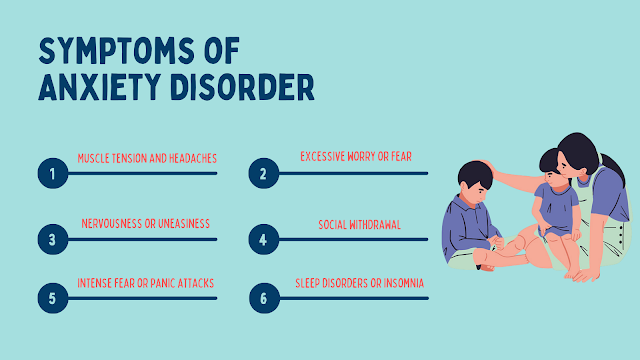Anxiety in Children: Signs, Symptoms, and Solutions
For kids, growing up may be a difficult process, and anxiety
frequently makes an unwelcome companion. It is crucial for parents and other
primary caregivers to comprehend how worry affects a child's life and offer the
appropriate support. In this blog article, we will delve into the world of
childhood anxiety, looking at its various manifestations and learning useful
techniques to assist our kids cope with their fears. We can foster a supportive
environment that enables kids to thrive despite fear by arming ourselves with
information and empathy.
 |
| Symptoms of anxiety disorders |
Symptoms of anxiety
disorders:
Physical Symptoms:
- Palpitations or a rapid heartbeat
- Difficulty breathing or shortness of breath
- Headaches and tense muscles
- Either sweating or shaking
- Intestinal problems or an upset stomach
- Fatigue or issues with sleeping
- Excessive concern or dread
- Overthinking or rushing thoughts
- Inability to focus or make decisions
- Unreasonable ideas or beliefs
- Negative thoughts
- Angry or restless behavior
- Dread implies a sense of impending danger
- Uncomfortable or anxious feelings
- Panic or extreme phobia
- Aware all the time or on edge
- Avoidance of certain events or locations
- Social exclusion or isolation
- Rituals or compulsive actions
- Nail biting, fidgeting, or other anxious behaviors
- Having trouble with daily tasks or obligations
 |
| how to deal with kid life Anxiety |
The Many Faces of
Childhood Anxiety:
Children's anxiety can take many different forms, each with
its own challenges and peculiarities. Separation anxiety disorder (SAD)
produces distress when a loved one is separated from you, whereas generalized
anxiety disorder (GAD) generates excessive worry and apprehension about
everyday events. While individual phobias and panic disorders concentrate on
certain triggers, social anxiety disorder (SAD) is characterized by a severe
fear of social interactions. Understanding the various sorts of anxiety can
help us better spot the symptoms and offer our kids the right kind of support.
Generalized Anxiety Disorder (GAD):
GAD frequently causes children's normal worries and fears to
become excessive. Their thoughts are constantly racing with what-ifs and the
worst-case situations related to everything from homework to social encounters.
It is essential to their wellbeing to assist them in overcoming this ongoing
anxiety cycle.
Separation Anxiety Disorder (SAD):
When youngsters are away from their loved ones, whether they
be parents or caregivers, SAD results in misery. Being separated from their
safe and comfortable environment can cause them to experience strong emotions,
making it a tough experience for them.
Social Anxiety Disorder (SAD):
For kids, social anxiety is characterized by a strong fear of
social situations. Daily tasks like speaking in class, taking part in group
activities, or meeting new acquaintances can cause excruciating anxiety, which
can result in avoidance and isolation.
Specific Phobias and Panic Disorders:
Children who have specific phobias are extremely afraid of certain things or circumstances, such as spiders, heights, or flying. On the other side, panic disorders can lead to abrupt, overpowering panic attacks that frequently leave kids feeling helpless and afraid.
Recognizing Anxiety in Children:
Since their symptoms may differ from those felt by adults,
diagnosing anxiety in youngsters can be difficult. Physical markers of anxiety,
such as a rapid heartbeat and muscle tension, as well as behavioral indicators
like impatience, restlessness, or withdrawal, may be present. Since persistent
and exaggerated fears can have a big impact on a child's day-to-day existence,
it's critical to distinguish between normal worries and anxiety disorders. It's
critical to establish a welcoming environment where children may communicate
their feelings and worries without fear of repercussions.
Unmasking the Causes
and Risk Factors:
Children's anxiety can have a variety of causes and risk
factors. The child's surroundings and social interactions, as well as genetic
predisposition and family history, all play a part. Anxiety can be exacerbated
by traumatic events or unfavorable childhood experiences, as well as by
parenting practices that unintentionally encourage excessive worry. Parents and
other adults who are responsible for children can address these issues and
lessen the impact that anxiety has on their lives.
Strategies for
Empowering Children:
A multifaceted strategy is needed to support youngsters who
are anxious. The first step in fostering a supportive workplace is recognizing
their feelings and offering assurance. Children who struggle with anxiety can
learn effective coping skills like deep breathing exercises, mindfulness, and
encouraging self-talk. To maintain a balanced lifestyle, it's important to
engage in physical activity, eat well, and get enough sleep. Additionally,
cognitive-behavioral therapy and expert treatments can give kids and their
families useful tools.
Establishing
Anxiety-Resilient Communities:
The wellbeing of a child is greatly influenced by their
schools and community. For anxious kids, a comprehensive support system is made
possible by collaboration between parents, teachers, and mental health
specialists. You may significantly lessen the impact of anxiety by implementing
modifications in educational settings, encouraging social-emotional learning,
and cultivating a happy and inclusive environment. By cooperating, we can build
environments where kids can grow in resilience and feel free to realize their
potential.

Post a Comment